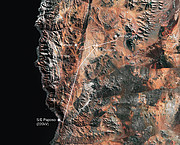Annuncio
Paranal–Armazones to be Connected to Chilean Power Grid
19 Giugno 2014
ESO has signed an agreement with the company Grupo SAESA to connect its sites at Cerro Paranal and Cerro Armazones to the Chilean electric power grid. The new connection will reduce costs and provide greater reliability and stability, as well as reduce the observatory’s carbon footprint.
The remoteness of the Atacama Desert presents significant challenges to ESO’s operations at its ALMA and Paranal observing sites as they currently have no connection to the Chilean power grid [1], relying instead on their own supply of energy. A power generating station currently operates at Paranal to supply the observatory [2].
Despite the addition of the VISTA and VST survey telescopes, power use has remained stable over the past few years at Paranal. As just one example, a new, more modern laser guide star was recently installed at Paranal (ann11039), effectively reducing the power consumption to less than a tenth of the old laser.
The future needs of the European Extremely Large Telescope (E-ELT) at Cerro Armazones, 22 kilometres east of Cerro Paranal, now warrant a connection to the grid to satisfy the electric power requirements at both sites.
The Chilean government has strongly supported hosting the E-ELT on Chilean land (eso1139). The Chile–ESO agreement on the E-ELT resulted in a new agreement with Grupo SAESA (Sociedad Austral de Electricidad S.A.) for the sites to be connected to a 220 kilovolt substation through a 220/66 kilovolt power transformer, a 66 kilovolt overhead line and a 66/23 kilovolt substation. Both Cerro Paranal and Cerro Armazones will be connected to this 66/23 kilovolt substation by means of two separate 23 kilovolt overhead power lines. A dedicated 23/10 kilovolt power transformer will be installed to adapt the 10 kilovolt system currently operating at Cerro Paranal to the 23 kilovolt of the grid [3]. It is foreseen that the grid connection will be completed in 2018.
With the grid connection at Paranal and Armazones ESO will also become a “regulated electricity customer” of the Chilean Sistema Interconectado Central. The grid connection is one of a series of initiatives ESO is taking to tackle the environmental impacts of its operations as it will not only reduce costs and increase the reliability and stability of the power supply, but also significantly reduce the observatory’s carbon footprint.
In the Chilean interconnected power systems non-conventional renewable energy sources are going to constitute an ever-growing share of the power and energy mixes. Green energy in the grid is strongly supported by the Chilean government, who aims to increase the overall Chilean green energy component to 25% by 2020, with a possible target of 30% by 2030.
Notes
[1] The main electricity grid in Chile spanning most of Chile from III Region (Atacama) in the north to X Region (Los Lagos) towards the south is known as the Sistema Interconectado Central (SIC, Central Interconnected System). In the north, the Sistema Interconectado del Norte Grande (SING) extends from XV Region (Arica y Parinacota), through I Region (Tarapacá) and down to the II Region (Antofagasta).
[2] The power generating station at Paranal currently comprises one multi-fuel turbine-generator set (rated about 2.6 Megawatts at the site) and three diesel generator sets (3 x 856 kilowatts). All generators are directly connected to the medium voltage (10 kilovolt) distribution system at the Paranal Observatory.
[3] The power line will connect to the substation to be built close to Paranal. A main high voltage transformer will be used to step the voltage down to the Armazones voltage level. Paranal will be connected through two transformers, so as to retain the ability to provide power to Armazones using the standby generators in case of power failure. A medium voltage substation will also be built at the Armazones summit area.
More Information
ESO is the foremost intergovernmental astronomy organisation in Europe and the world’s most productive ground-based astronomical observatory by far. It is supported by 15 countries: Austria, Belgium, Brazil, Czechia, Denmark, France, Finland, Germany, Italy, the Netherlands, Portugal, Spain, Sweden, Switzerland and the United Kingdom. ESO carries out an ambitious programme focused on the design, construction and operation of powerful ground-based observing facilities enabling astronomers to make important scientific discoveries. ESO also plays a leading role in promoting and organising cooperation in astronomical research. ESO operates three unique world-class observing sites in Chile: La Silla, Paranal and Chajnantor. At Paranal, ESO operates the Very Large Telescope, the world’s most advanced visible-light astronomical observatory and two survey telescopes. VISTA works in the infrared and is the world’s largest survey telescope and the VLT Survey Telescope is the largest telescope designed to exclusively survey the skies in visible light. ESO is the European partner of a revolutionary astronomical telescope ALMA, the largest astronomical project in existence. ESO is currently planning the 39-metre European Extremely Large optical/near-infrared Telescope, the E-ELT, which will become “the world’s biggest eye on the sky”.
Links
- Green ESO page
- ESO, the E-ELT and the Grid Electricity Supply for the VLT and E-ELT (.ppt presentation in Spanish and English)
- Grid Electricity Supply for the VLT and E-ELT (procurement brochure in English)
- SAESA Group (Sociedad Austral de Electricidad S.A.)
Contatti
Roberto Tamai
ESO E-ELT Programme Manager
Garching bei München, Germany
Tel: +49 89 3200 6367
Email: rtamai@eso.org
Lars Lindberg Christensen
Head of ESO ePOD
ESO ePOD, Garching, Germany
Tel: +49 89 3200 6761
Cellular: +49 173 3872 621
E-mail: lars@eso.org
A proposito dell'annuncio
| Identificazione: | ann14049 |
Our use of Cookies
We use cookies that are essential for accessing our websites and using our services. We also use cookies to analyse, measure and improve our websites’ performance, to enable content sharing via social media and to display media content hosted on third-party platforms.
ESO Cookies Policy
The European Organisation for Astronomical Research in the Southern Hemisphere (ESO) is the pre-eminent intergovernmental science and technology organisation in astronomy. It carries out an ambitious programme focused on the design, construction and operation of powerful ground-based observing facilities for astronomy.
This Cookies Policy is intended to provide clarity by outlining the cookies used on the ESO public websites, their functions, the options you have for controlling them, and the ways you can contact us for additional details.
What are cookies?
Cookies are small pieces of data stored on your device by websites you visit. They serve various purposes, such as remembering login credentials and preferences and enhance your browsing experience.
Categories of cookies we use
Essential cookies (always active): These cookies are strictly necessary for the proper functioning of our website. Without these cookies, the website cannot operate correctly, and certain services, such as logging in or accessing secure areas, may not be available; because they are essential for the website’s operation, they cannot be disabled.
Functional Cookies: These cookies enhance your browsing experience by enabling additional features and personalization, such as remembering your preferences and settings. While not strictly necessary for the website to function, they improve usability and convenience; these cookies are only placed if you provide your consent.
Analytics cookies: These cookies collect information about how visitors interact with our website, such as which pages are visited most often and how users navigate the site. This data helps us improve website performance, optimize content, and enhance the user experience; these cookies are only placed if you provide your consent. We use the following analytics cookies.
Matomo Cookies:
This website uses Matomo (formerly Piwik), an open source software which enables the statistical analysis of website visits. Matomo uses cookies (text files) which are saved on your computer and which allow us to analyze how you use our website. The website user information generated by the cookies will only be saved on the servers of our IT Department. We use this information to analyze www.eso.org visits and to prepare reports on website activities. These data will not be disclosed to third parties.
On behalf of ESO, Matomo will use this information for the purpose of evaluating your use of the website, compiling reports on website activity and providing other services relating to website activity and internet usage.
Matomo cookies settings:
Additional Third-party cookies on ESO websites: some of our pages display content from external providers, e.g. YouTube.
Such third-party services are outside of ESO control and may, at any time, change their terms of service, use of cookies, etc.
YouTube: Some videos on the ESO website are embedded from ESO’s official YouTube channel. We have enabled YouTube’s privacy-enhanced mode, meaning that no cookies are set unless the user actively clicks on the video to play it. Additionally, in this mode, YouTube does not store any personally identifiable cookie data for embedded video playbacks. For more details, please refer to YouTube’s embedding videos information page.
Cookies can also be classified based on the following elements.
Regarding the domain, there are:
- First-party cookies, set by the website you are currently visiting. They are stored by the same domain that you are browsing and are used to enhance your experience on that site;
- Third-party cookies, set by a domain other than the one you are currently visiting.
As for their duration, cookies can be:
- Browser-session cookies, which are deleted when the user closes the browser;
- Stored cookies, which stay on the user's device for a predetermined period of time.
How to manage cookies
Cookie settings: You can modify your cookie choices for the ESO webpages at any time by clicking on the link Cookie settings at the bottom of any page.
In your browser: If you wish to delete cookies or instruct your browser to delete or block cookies by default, please visit the help pages of your browser:
Please be aware that if you delete or decline cookies, certain functionalities of our website may be not be available and your browsing experience may be affected.
You can set most browsers to prevent any cookies being placed on your device, but you may then have to manually adjust some preferences every time you visit a site/page. And some services and functionalities may not work properly at all (e.g. profile logging-in, shop check out).
Updates to the ESO Cookies Policy
The ESO Cookies Policy may be subject to future updates, which will be made available on this page.
Additional information
For any queries related to cookies, please contact: pdprATesoDOTorg.
As ESO public webpages are managed by our Department of Communication, your questions will be dealt with the support of the said Department.


